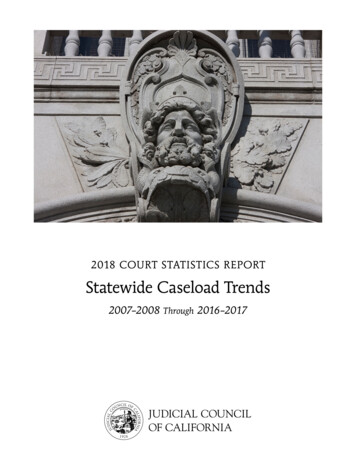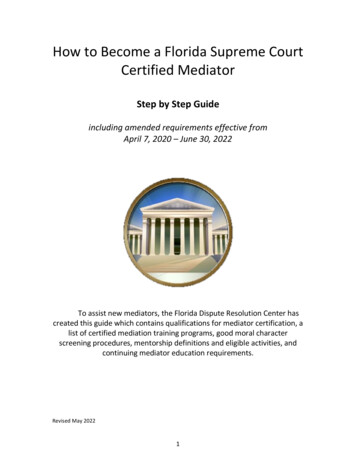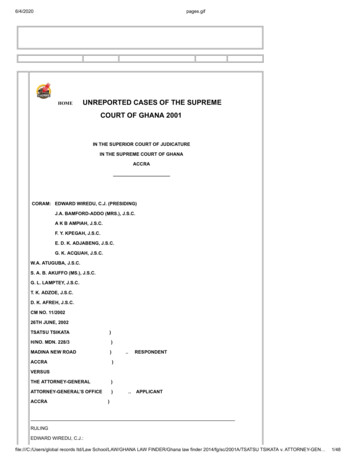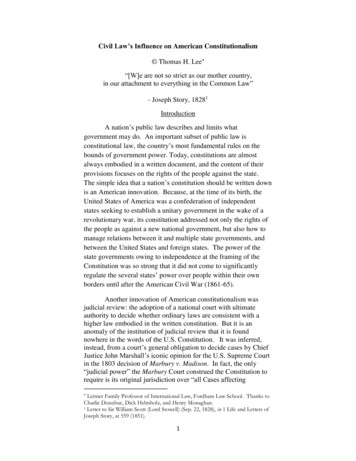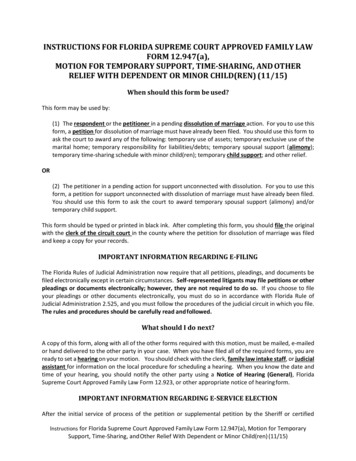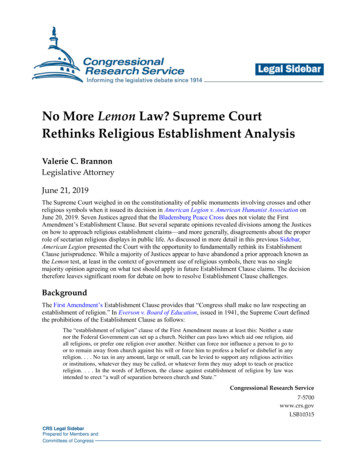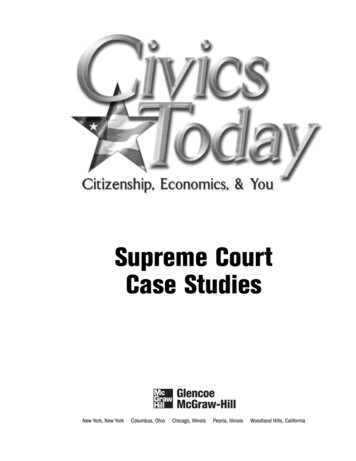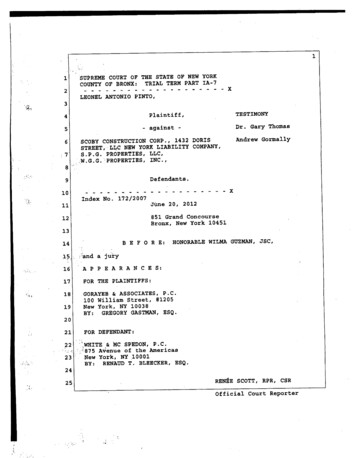
Transcription
1. .,1SUPREME COURT OF THE STATE OF NEW YORKCOUNTY OF BRONX: TRIAL TERM PART IA-7- - - - - - - - - X2LEONEL ANTONIO PINTO,34TESTIMONYPlaintiff,5Dr. Gary Thomas- against -6Andrew GormallySCOBY CONSTRUCTION CORP., 1432 DORISSTREET,L C NEW YORK LIABILITY COMPANY,S.P.G. PROPERTIES, LLC,.:W.G.G .PROPERTIES, INC.,:78:. .';Defendants.910-------------------- XIndex No. 172/200711JUne 20, 201212851 Grand ConcourseBronx, New York 1045113B E FOR1415.,E:HONORABLE WILMA GUZMAN, JSC,;.16A P PEA17FOR THE PLAINTI FS:18GORAYEB & ASSOCIATES, P.C.100 William Street, #1205New York, NY 10038BY: GREGORY GASTMAN, ESQ.19RANC E S:20FOR DEFENDANT:21.',WHITE & Mc SPEDON, P.C.: 875 A"i7enueof the AmericasNew York, NY 10001BY: RENAUD T. BLEECKER, ESQ.222324RENEE SCOTT, RPR, CSR25Official Court Reporter . ,:.:. "
iI,Proceedings22THE COURT:3COURT OFFICER:4(Jury enters5THE COURT:ladiesJURORS:9THE COURT:courtroom;Good morning,Good morning.We'reready to continue.you wantto call your next witnessplease.MR. GASTMAN:12Yes.Thank you, your Honor.this time, we call Dr. Gary Thomas14(Witness approaches15THE CLERK:16THE WITNESS:DOC17TORYon behalfof the Plaintiff,19took the stand and testifiedTHE CLERK:21and your professionalTHE WITNESS:2210 UnionSquarewitnessstand.)havingTHOM A 8, a witnessTHE COURT:25MR. GASTMAN:calledfirst been duly sworn/affirm,as follows:Please have a seat.addressState your namefor the record.Dr. Gary Thomas.OfficeEast, New York, New York 10003.24stand.Good morning.GAR20,to the witnessAtGood morning.1823the followingPlease have a seat.Mr. Gastman,1013All rise.and gentlemen.811Get the jury in.occurred: )67S E S S IONM 0 R N I N G1You may inquire.Thank you.address:
Dr. Thomas. Plaintiff - Direct31DIRECT EXAMINATION2BY MR. GASTMAN:Dr. Thomas, good morning.34A.Good morning.5Q.I want to point out what others have pointed out to6me.The acoustics in this room are not good so just keep your7voice elevated so everybody can hear you.89Thank you.Doctor, are you licensed to practice medicine in theState of New York?10A.Yes, I am.11,Q:And for approximately how long have you been so12licensed?13A.Since 1995.14Q.Do you presently maintain a medical office somewhere1516in New York City?A.Yes, I do.I have an office in Beth Israel Medical17Center in Union Square and in Brooklyn affiliated with Methodist18;Hospital.' r.192021Q.Thank you.Doctor, your medical practice, is it somesort of medical specialty?A.My specialty is pain management, which I'm board22certified in anesthesiology and pain management.My practice is23now exclusive to pain management, interventional pain24management, medication management and the treatment of patient's25with severe injuries.
Dr. Thomas .Plaintiff - Direct41Doctor, I heard the word ncertificationn somewhere inQ .2there.3medicine?4A.Are you board certified in some way in the field ofI'm board certified by the American AMA medical board5in both anesthesiology and pain management.6oral -- two-day oral and written test testing your knowledge.7About 30 percent of doctors become certified and they're usually8the teachers, the professors, the ones that go to tertiary care9center to relieve the other doctors in the movement of medicine.'-.',.101112Q.It's a test withDoctor, could you please tell us what type of patientsyou typically see in your office?A.Pain management is a broad field that takes care of13patients with different type of pain disorders.14specific certification is in interventional pain management15where I see patients, take a history, and I see patient's with16cancer'pain, crush injuries, burn injuries, patients with17neuropathy such as diabetic neuropathy, HIV neuropathy, post18chemo destruction of the nervous system, brain injuries.19My real -- myAny time the body becomes damaged and it needs chronic20care, especially when the nervous system becomes damaged where21it needs specialized care, is where I come in.22the primary care doctor for their injuries. 3:organ;ze the orthopedic doctors, ,therehap doctors, other24specialists to come in and manage but 11m the doctor that sees25them on a weekly or monthly basis giving them pain medications,I often becomeI would often
Dr. Thomas. Plaintiff - Direct51doing the specialized procedures into the crushed joint, damaged2nerve, installing the computer into the nervous system to3reprogram the nerves.4room; half my time is spent in managing patient care.Q.5Thank you.Half my time is spent in the operatingDoctor, as you know, this case, what's6brings us all together, is Mr. Leonel Pinto.7yours?8A.Yes, he is.9Q.I see you have your chart with you.Is he a patient ofDoctor, you10should also know through the subpoenaed records process a copy11of your file is marked into evidence.Doctor, can you tell us approximately when did Mr.1213pinto begin to come under your care?A:14,15I first saw Mr. Leonel pinto in 9/27 2007,September 27, 2007.Q.16And, Doctor, when you met with the patient for the17first time, did you get something of a history to find out what18brought him into your office?A.19Yes.Mr. Pinto describes severe pain in his lefthand, radiating up his arm, through his forearm, elbow,20)21shoulder, described as severe, eight out of ten.I asked Mr.22pinto a history of how this happened and he described that he23was during -- while at work, he fell down some stairs while24carrying heavy boxes.25As he fell, he injured his hand and the boxes fell on the handI believe it's some sort of ceramic tile.
Dr. Thomas. Plaintiff Direct61with a crush injury to the hand and fingers causing open2fractures.3was -- I don't recall, possibly Montefiore Hospital and where4they placed open reduction and pins of the broken bones.5finger was essentially completely shattered off, dislocated from6the other hand and there was crush injury along the other7fingers as well.c89Thewith other orthopedic doctors where he had subsequent care of10removing the pins, physical therapy and initial, you know,11simple pain medication from the doctors.When it was apparent that the patient wasn't improving13and he was having a severe neuropathic pain, he was referred to14me because my specialty is in the complex regional pain15syndrome, damaged nerves, trying to rehabilitate nerves, nerving16programming.17pain that had rated eight out of ten on a daily basis,18especially whenever he moved or used his hand or even touched it19or exposed to cold weather.20injuries.21.'I believe itAfter the initial care at the hospital, he followed up12. Patient was taken to the hospital.Q.He was sent to me because of this burning nerveThank you Doctor.It's a syndrome.It happens withNow, Doctor, the crush injury as22was explained to you by the patient, would that be a painful23injury?24A.Yes, very painful.25Q.Doctor, your understanding of the injury that took
Dr. Thomas.Plaintiff Direct71place at Montefiore Hospital on the evening of the accident that2involved metal wires inserted into the hand, true?3A.Yes.4Q.Would that surgical procedure be painful?5A.That would be very painful.A patient would wake up6with essentially wires sticking out of his skin, almost like7from some science fiction movie, it would be very painful.8couldn't move it.9painful.YouAny touching of the wires is extremelyDue to this -- due to the crush injury, the damage and.I. . 'ltl;',10the cutting of the nerves and the subsequent immobili2ation, the11neuropathic12feature throughout his pain, not only the destruction to the13joint, the damage to the tendons, the loss of function but thel4severe burning pain has been a dominant feature throughout his15care. ,1, ".:;:1617'1819Q.syndrome set in which is one -- has been a dominantDoctor, if you would, could you please walk us through'the treatment that you and your office provided to Mr. Pinto asa result of this accident?A.When we first saw him, he was in severe pain, almost20crying when because of the severe pain shooting down his arm.21He had been on physical therapy which he had to stop because of22the severe pain.He couldn't even touch the hand.23,hypersensitive.2 "with the cut nerve, numb.25He wasIt was red and blotchy and with the fingersSo the cut nerves are numb and allthe hand around it was hypersensitive.
Dr. Thomas. Plaintiff Direct8Due to the severe pain, we did a immediate steroidinjection, a cervical, epidural steroid injection to just to tryto calm the nervous system down by putting steroids on to thenerves that go down into the arm.2009.We did this on September 27,We also gave him oral medications for nervous painsystem, for the nerves, neuropathic pain.And we put in uthori ation for more advanced radio frequency sympathectomyfor the left upper extremity also known as nerving programmingin order to turn down that severe neuropathic burning pain orthe complex neuropathy also known as a subtype of complexregional pain syndrome that he had and was referred to me andthat after discussions with Dr. Lenzo when he came to the officeDr. Lenzo was very worried this was the complex -MR. BLEECKER:THE COURT:Q.Objection, your Honor.Sustained.Doctor, getting back to your initial office visit.That was September 27, 2007; is that correct?A.Yes.Q.Okay.And it was on that date yo gave Mr. Pinto hisfirst cervical epidural steroid injection, true?A.Yes.Q.Doctor, what are trigger point injections?A.Trigger points injections are injections for lockedmuscles.Due to his nerve injury, the nervous system pain wentup the arm, the contractures of the arm.A trigger point
Dr. Thomas. Plaintiff Direct91injection is an injection into the contracted muscles that had2occurred in his forearm, arm and neck and shoulder area due to345severe nerve pain. :.- So that's different than the epidural steroidQ.injection, correct?6A.Yes, it is.7Q.Did Mr. Pinto receive trigger point injections from8you on the initial office visit in addition to the cervical9steroid injection?10A.Yes, yes, he did.11Q.Okay.1213And, Doct r, was there also any medication,oral medication prescribed to the patient at that time?A.He was already on an antiinflammatory so we continued14that.15nerve pain medication to calm down the burning, shooting pain in16his hand.17181 20We started him on gabapentin or Neurontin which is aQ.Doctor, let me stop you right there.Neurontin, is,-.that pain medication in the ordinary sense or is this somethingdifferent?A.I would say it's an atypical pain medication.21used to calm nerves that are damaged or hyperexcited.22for seizures.23can misfire and cause a seizure.24to a nerve, the nerve essentially arks.25ratches into it; it arches out.It'sIt's usedWhenever you have damage to the brain, the nervesWhen you have a crushed injuryIt's like a wire thatBy giving medication and the
Dr. Thomas - Plaintiff - Direct101procedure we talked about, we can calm down the shooting,2burning pain down the arm.3him Skelaxin which is a strong muscle relaxer to release the4axial and extremity muscles.Okay.5Q.6authorization7A.89Due to his severe pain, we also gaveNow, Doctor, you said something about seekingfor radio frequency sympathectomy something?It1s a -- it's a long word for putting an electrodeinto the spine.The nervous system -- the ganglion, thatcontrols pain, that goes down into the arm.It's done on theof10side of the patient's neck with a 9-inch needle that goes down11into the spine and emits a computer energy which is a very12strong energy, also like microwave or laser and I applied it to13the sympathetic change or the of the ganglion.14nervous system that controls pain.15complex pain syndrome, complex regional pain, a subtype of RSD,'",- . ': ': :.: :", J16This is part ofDue to his diagnosis ofthis would be the treatment, both diagnostic and therapeutic for'.1?:.1819'his condition.Doctor Thomas, did Mr. pinto eventually undergo radioQ.frequency sympathectomy at your office?20A.21did it.We finally got authorization and did it a while later.22Q.Now, Doctor, Botox, what is Botox in terms of medical232425It took a while to get authorization but we eventuallytreatment.A.It could be used in many -- as most people know, it .!could be used for relaxation of a muscle for decreased wrinkles
Dr. Thomas.Plaintiff .Direct1112.'c'but in this case with Mr. pinto he has contractures of his hand.Q.Well, let me stop you right there.Contractures of3the hand, could you explain please in lay person's term, what4does a doctor mean when he uses the word lIcontracturell?5A.Mr. Pinto had cut nerves and crushed nerves.Due to6this problem along with the damage to the joints and the7tendon , the hand no longer opens and closes easily.8had been damaged and the hand sits in a clawhand position.9permanently contracted.The nervesIt'sWhen the nervous system gets damaged10and no longer knows how to open and close a hand, often half the11nerve is damaged or the other half isn't damaged.12a part a total transection with partial crush of the other13nerves which resulted in a hyperextension of the first few parts14'of the third, fourth and fifth fingers.This would beSo bend back and the15.fingers claw forward.16forearm, his arm and his neck.17crl,lshednerve the nervous system essentially got confused and18can't function properly and where it does function, it functions19to place a patient in a locked position.2021So he had locked muscles up in hisDue to the cut and damageThe Botox is a way to release the fingers by doing.injections into the locked muscles.The nervous system is22,confused and it's locking down certain muscles in both bending23back and a bending forward because it doesn't know how to24function any more.25in order to allow some relaxation of the hand and that way theBotox is placed into the muscles that lock
Dr. Thomas. Plaintiff Direct12.'1hand can be opened and possibly he has very -- Mr. pinto has2a difficult time grabbing, lifting things because the hand is3always locked forward.4it up a little bit in order to at least have some function with5the first two fingers and it allows him to have less pain.This allows him to -- allows him to openwith that severe muscular contraction all the time,67it's painful.Because if you like hold a fist for like a day, I8don't think anyone could hold a fist for like five minutes until9it just starts to hurt.You can't do it.You don't get into it.10it.11he has on a daily basis.On a break, tryAnd that's just one of the levels of painBy releasing that locked down, he can12.release some of the musculoskeletal joint pain that he has all13'the time and approve some of the functions and the injections14were done and they helped quite a bit with that layer of pain.151617Q.That was my next question pain question, Doctor. DidMr. Pinto eventually undergo a Botox injection procedure?A.Yes.It took a long time to get authorization but18finally we did and by injecting the medicine into the muscles19that were locked he is able to move the arm more freely, he was20able o 'open up the fingers and they still didn't have much21f ction22one finger is totally useless; the others he has minimal23function of the fourth and fifth.24improved but the treatments only last six to nine months and25then the contractures start coming back.,:, ,.but at least they weren't in a clawhand.One handAfter the treatments, h has
Dr. Thomas - Plaintiff - Direct13IQ.12When you say the treatment offered some help for sixto nine months is that the Botox treatment you're talking about,A.4The Botox treatment helped about -- he says about530 percent but it helped markedly for opening up the two6fingers, about 30 percent of his total pain syndrome and after7about the six to nine months the fingers start clawing back8again and he loss the ability to hold it in that open position.9Both the trigger point injection -- the trigger point injectiondo a similar function but only lasts for a couple of weeks and10I. ";the Botox allows the hand to be opened up and last for six tonine months depending on the patient.12Q.13"14frequency sympathectomy, that's when the nerve was burned,15correct?16A.Yes.17Q.Okay.18'fIs that a permanent fix, Doctor?Does it last':for a particular period of time or something else?""19A.That one also last about six to nine months.He had20about -- he described his total pain syndrome about 5021improvement in the pain because his nerve pain was so much more22dominant of the over the muscle pain he valued the nerving23programming as much more helpful.24hypersensitivity to touch anything cold did not cause severe25."Now, Doctor, getting back for a moment to the radioHe was able -- the.pain .',Hewas actually able to use the hand for brief, slightly
Dr. Thomas. Plaintiff Direct141longer 'periods of time because any use of touching of the hand2Causes severe pain.3pain gets severely painful, the hand gets severely painful just4in the irritation of the nerves and the tendons just because of5the complex regional pain syndrome that he has.6789Even if he uses the first two fingers, theDoctor, did Mr. Pinto continue to remain under yourQ.care after those initial office visits.Yes, he did.A.He followed up for medications andcontinued to fight for the therapy, the physical therapy, the10orthopedic care and the treatments that he needed.11very difficult fight to get authorizations for him.12It was aDoctor, does your chart indicate the approximateQ.13frequency with which the patient continued treating with your14office?15A.16While he was in severe pain, it was approximately"monthly.17Q.Thank you.18A.After he had some improvement from the procedures, he19was able to follow up at the -- approximately every three20months.21the pain syndromes.2223Q.When the pain was severe, he's back to a monthly due toNow, Doctor, each time Mr. Pinto met with you as yourpatient you would exam him?24A.Yes.25Q.You would ask him how he's doing?
Dr. Thomas. Plaintiff Direct151A.Yes, I did.2Q.And your chart would reflect those findings, true?3A.A summary of those findings, yes, not everything can4be documented in an office notes but the dominant points are5reported in a doctor's notes.67Q.Okay.And are those summaries available for you toreview as needed?8A.Yes, they'reright9Q.All right.here.Doctor, but if I ask you, can you tell us10please when you saw the patient -- the accident was in d you began treating him in 2007, correct?move forward.17office visit in December of 2007, December 3rd I believe it is?18A.Let me find that day.19Q.Okay.20A.Yes.21office.22Q.And did he complain of any pain to you?23A.His main complaints was left hand dysfunction andDecember 3rd, 2007 I saw Mr. pinto in the24severe burning, tingling pain starting in his hand and radiating25up into his upper arm and shoulder.
Or. Thomas. plaintiff Direct162that going up the arm from the hand area?What does that mean?. 4What's, wrong with this patient?Well, first of all, he rates he has an obviousA.56elawhand deformity of his hand but that's not even what he's7complaining about.8severe, shooting, burning pain.9if you put your hand down a block of ice and just leave it there10"" tWhat does thatmean to you and to your practice when you hear about burning and3 Ji:.Let me stop you right there, Doctor.Q.1for a day.11He rates the pain as eight out of ten of theHe described it similar to likeIt's constant like this, this cold burning, numb,.I mean, he says the numbness and burning j,sjust incredible.\Whenever a patient has that, burning, tingling, ofteni2,13denotes that it's a nerve, - on the nervous system level of14pain.15tendons, the .nerves, the skin, internal organs.16that it waS a pain involved with the nervous system.17'. j;. ,'1819-. .-1.Y.ou can have a pain i the bones, the joints, theThis show meAnd, Doctor, you continue to treat him in 2008,Q.Okay.A.Yes.Q.Would you agree or disagree that you were seeing Mr.,true?of2021pinto in 2008 approximately monthly?22A.Yes.23Q.Doctor, do you have office notes for 2008 with y u?24A.Yes.25Q.Okay.,i'l:!L.,March, March 2008.Did you see him then?
Dr. Thomas - Plaintiff Direct171A.March 13, 2008 I saw him.2Q.And what did the patient complain of?3A.Patient complained of continued left-hand pain with4contractures and severe achy and burning pain.He described the5medications6were helping partially to treat his benefit.7therapy, physical therapy and trigger point injections but the8benefit from those was fading.9months and now he was having a decreased range of motion of thethat were provided him as helping but he had -- theyIt wasWe had doneIt only lasted for a couple ofhe was having less ability to open it and this10hand.11would seem to be progressive over the last few months with12numbness and burning in the hand.13nerve pain, we requested the radio frequency cervical14sympathectomy to simplify the nerving programming and to calm15down that severe burning pain.Q.1617Again, due to this severeDoctor, we won't have time to cover each and everysingle office visit. I'm going to move forward just a little bit1.8,in time.Did you see the patient in November of 2008?1.9A.November 24, 2008, yes.20Q.What were the patients complaints at that time?21A.His complaints are pretty consistent.He described22the primary pain as the tingling, weakness, burning, numbness in23the left hand.24motion because whenever he moved the hand the burning got so bad25the hand would claw down.,';.i." ".He had continued progressive decreased range ofThe burning seemed to be linked to
Dr. Thomas - Plaintiff - Direct181his muscular contraction.So when the nervous system got2activated, the hand would claw down more.He was having a sharp, shooting pain into his hand34eight of ten and medications helped some.Medications helped a5little, rest helped a little but what made it worse was range of6motion, any cold exposure or any touch or any use of the arm.7We were still giving him the neuropathic pain medications,Bantiinflammatory medications.We were adding more nerve numbing: medications10Lidocaine into the hand itself in order to calm down the severe11burning he had and again we were fighting -- we had a court date12for -- to get authorization for the nerving programming because13the burning continued to get worse and worse and worse.1415Q.called Lidoderm patches which are patches that hasDoctor, did you see the patient again the followingmonth?A.Yes.17Q.And which procedure was that, Doctor?18A.We finally -- Mr. pinto finally got with the Court and16We saw him for the procedure.19got authorization for the radio frequency.MR. BLEECKER:2021Q.Just talk about the medical treatment, Doctor?THE COURT:2223A.2 .performed25Objection, your Honor.Okay.Sustained.We performed the radio on 12/17, 2008.Wethe radio frequency cervical sympathectomy which is aoperating room procedure.The patient is placed on the
Dr. Thomas. Plaintiff Direct19;.1operatingroom table, sterile2over the patient,3calm him down.4needle,5into the nervous6the adjacent7systemBpain9It's subtypespatientRadiois advancedthroughprobe, whichsyndromeis broughtthat controlsthe sympatheticor complexneuropathyof the pain syndrome.in orderintois a about a 9-inchthe skin, passedthe blood vessels,the nerveside of the spinal cord.that controlscameraoften has some sedationfrequencysystemx-rayjust adjacentThe sympatheticpain or complexor RSD.onnerveregionalIt's all the same.It's types of this painsyndrome.10And by putting,11placing12chain, you emit a frequency13energy.14,drapes,the probeof energy calledIt -- no one understandsit's an energyonto the sympatheticthat essentiallyradiowhat radiofrequencyfrequencycooks the nerve.is butIt heats up to.;,.15a pointthat it stuns the nerves16it canlt17best way to describe18or microwave19this on cadavers,20call it laser or microwave21what welre22immediatefunctionany tlook.and pouched.so a patientThis helped.to sleep.like when you microwaveit gets that poachedit looks whitepain reliefthat it has toSo we put the nerveit is almostsomethingso severelyan eggIf you doSometimesyoucan kind of figureWe did the procedure.then he followedup a monthTheoutHe hadlater.is diaphoresis?is used in differentor lack of sweatingways,usuallyin the hand, part of the basil,
Dr. Thomas.Plaintiff Direct201basil motor symptoms of the sympathetic nervous system is2responsible for sweating and patients can have, you know, very3dry or very sweaty skin as compared to other parts of their body4on one side of the hand versus the other.567Q.What does that mean to a doctor when you have handsweating on one side but not the other?What does that mean?The nervous system is over -- the sympathetic nervousA.8system is over activated.9modelingThis is one indication along with-- he had all the signs -- modeling of the skin, color10changes, diaphoresis, cold temperature.11temperature testing.1291 degrees.13activation of the sympathetic nervous system which is the flight14or fight mechanism and the body just thinks the hand is being15destroyed.16system the body is overacting the sympathetic nervous system17which shuts down the hand.18muscles contracts and the hand essentially stops healing.19if it progresses to a later stage, it doesn't get treated, it20can turn into black clawhand.One side was 85 degrees; one side wasSo he definitely had this syndrome of overBecause there was so much damage in the nervousIt goes cold, very painful, the21MR. BLEECKER:22THE COURT:232425Q.Objection, your Honor.Sustained.Moving on, sir. Temperature, did you measuretemperature of this patient?A.We did two bilaterallyYes, several times.And
Dr. Thomas - Plaintiff - Direct211Q.And yourfindings?2A.Eighty-five.It was3. difference4difference5handshouldbe equal.After6theyshouldbe equal.And7temperature,8in the temperature9special10almoston one day; on anotherand thattherea lO-degreeday,it wasis on the same portionwas20 minuteseveryeitherbetweentemperaturea 6-degreeof the hand.in a normaltime we measurea moderatetheWe didA temperatureprobeTheenvironment,or marketedthe two hands.probe.temperaturedifferencea - we did athat I s veryaccurate.Andthe hand11Q.12observed13A.Yes.14Q.Doctor,the diaphoresis,wasthisin the patient.15period16sympatbetectomy?of timedid the patientfollowingHe was veryIL17. oskeletalpain,21the sympatheticover22lock23preventing24cause. severe25'this.furtherthe radiohappymakingthe joint,activation,the handburning .stillcervicalthe pain.for acervicalimprovementimprovementof theof theBecausewas makingwithoutthe musclesthe hypersensitivityany use becauseHe was veryhavingsomea 50 percentand also partialfrom him havingHe wasafterHe reportedpainreportany stimulation-- he wasa hard.someveryhappytime gettingforwould
Dr. Thomas.Plaintiff - Direct221authorizationfor his medications.2put him on medications3it, at most,4anti-inflammatories,5muscle6carefor what7nordo we get8.after--9Q.to get the benefitwe can get out of whichrelaxantsanti-neuropathicand physicalthe .surgery,21A.ofthe medicationsat thattime andI moveHonor,goingto striketheto court.and I'd liketo haveafact.that portionis strickenandon at this point.THE WITNESS:20Yourto that17afterauthorizedauthorization,MR.19andbe the standardnot ction14to--MR. BLEECKER:11includepaintherapy-- we wantedthat we had and makewouldwe ask for but we should1015.,.:And he stillgettingGASTMAN:it us allythe radioi3withIt usuallylastcomplex11mfrequencylastssix to nineregional24Q.Let move25A.Yes.painforwardyou,Judge.sorry.the improvementis that a permanent22Thankthatthe patientcervicalimprovementsympathectomyor something-- all patientselse?are differentmonthsin a typicalsyndromeor complexto the nextreportedyear,patient-- butwithneuropathy.20091a
Dr. Thomas - Plaintiff - Direct231Q.You saw the patient in 2009, true?2A.Yes.3Q.Okay.4A.I saw him in May.5Q.How about April?6A.April 14, 2009, yes.7Q.What was the patient's pain level at that point?8A.It was eight out of ten.9wearing off.10Q.How about in the spring of 20091The block was at that pointAnd, Doctor, trigger point injections that we spoke of11earlier, did this patient continue to get trigger point12injections over time from your office?1 ,A Yes.Due to the clocking of the hand, the clawhand14and the locking of the muscles all up through the right15neurological system, we frequently didn't -- a trigger point16injection.17it wasn't so bad, it would be every third month approximately.18These are sets of injections that injects a muscle unlocker19called Bupivacaine similar to Lidocaine.20an anesthesia medicine.21possible.22when it was severe, it would be every month.WhenDon't think of it asIt's our strongest muscle relaxerWe stick the needle into the locked muscle, especially23where there are bulbs or not or tenderization of the uscle and24inject medicine.25injecting it into a very tight locked knot but the benefit is:t'.It's a painful injeetion because you're
Dr. Thomas - Plaintiff Direct241immediate and it has, you know, for him about three to four2weeks of improvement allowing the hand to open and allowing the3muscles not to be locked up so much.Q.4You have anticipated my next question.And the5question is is relief obtained from trigger point injections5permanent or something else?A.7Temporary.It lasts about three to four weeks.Some8patient it can last up to four months but with constant nervous9system activation, they -- once the effect of the medicine goes10away, the nervous system ends up just locking up the muscles11again.Doctor, the patient is still presently under your12Q.13care, true?14A.Yes, he is.15Q.Have you been seeing him -- have you seen him16recently?A.1718.Yes.And in 2000 .- I'm looking at 2012 now.Mostrecent office visit was two days ago actually.19MR. BLEECKER:20THE COURT:21MR. BLEECKER:Well, Your HonorCounsel, he's the treating physician .
Dr.Thomas. Plaintiff Direct 6 1 with a crush injury to the hand and fingers causing open 2 fractures. Patientc was taken to the hospital.I believe it 3 was -- I don't recall, possibly Montefiore Hospital and where 4 they placed open reduction and pins of the broken bones.


